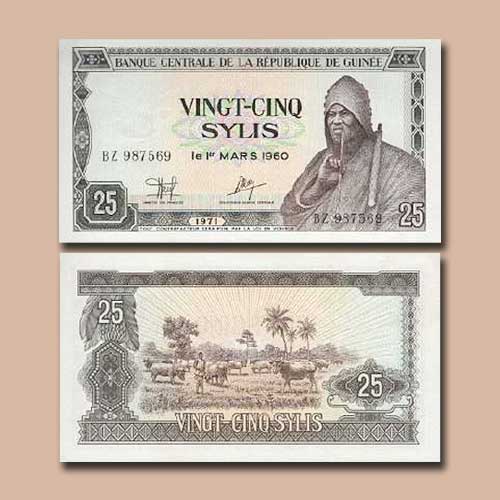Guinea 25 Sylis banknote of 1971
2019-03-26 Tue
Guinea is a country in West Africa, bordered on the west by the Atlantic Ocean. It's known for the Mount Nimba Strict Nature Reserve, in the southeast. The reserve protects a forested mountain range rich in native plants and animals, including chimpanzees and the viviparous toad. On the coast, the capital city, Conakry, is home to the modern Grand Mosque and the National Museum, with its regional artefacts.Guinea has abundant natural resources including 25% or more of the world's known bauxite reserves. Guinea also has diamonds, gold, and other metals. A major exporter of bananas, pineapples, coffee, peanuts, and palm oil, Guinea has considerable potential for growth in the agricultural and fishing sectors. Soil, water, and climatic conditions provide opportunities for large-scale irrigated farming and agro-industry.
The syli was the currency of Guinea between 1971 and 1985. It was subdivided into 100 cauris. Banknotes of the 1971 series were issued in denominations of 10, 25, 50 and 100 sylis. A second series of banknotes was issued in 1980, this time in different colours and with four additional denominations – 1, 2, 5 and 500 sylis notes.
The note alongside is a Guinea 25 Sylis banknote of 1971. The Obverse has the portrait of King Behanzin of Dahomey (1844-1906) smoking a pipe, while the reverse depicts a village scene with cattle and herder amongst stalk of bananas on a banana plant. This note has the Watermark of a dove.
Image Courtesy: Kate's Paper Money
Latest News
-
Mahatma
2024-04-25 ThuIndia Post issued a commemorative postage stamp on #LalaHansraj, also known as Mahatma Hansraj for�...
-
Berar Mint of Muhammad Akbar
2024-04-25 ThuBerar was a kingdom located in the Deccan region, with Elichpur as its capital. It was one of the Su...
-
Janma Kalnayak of Bhagwan Mahavir
2024-04-24 WedOn 21st April 2024 which was the 2550th Janma Kalnyanak of Bhagwan Mahavir Swami, PM Modi unveile...
-
Gold Pagoda of Vijaynagar Empire King Deva Raya I
2024-04-10 WedKing Deva Raya I of the Vijayanagara Empire was a patron of Kannada literature and architecture. He ...
-
Silver Denarius of Septimus Severus
2024-04-05 FriLucius Septimius Severus served as the Roman emperor from 193 to 211 AD. Severus sat on the throne o...

